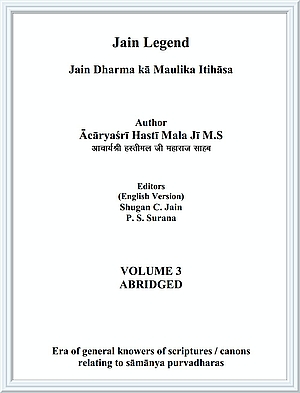- Mallavādī: Logician Ācārya Mallavādī belongs to the same period as of Ācārya Vīra Bhadra and Hārila. He composed philosophical and doctrinal text 'Naya Cakra' as well as commentary on 'Sanmati Tarka'.
- Candrarṣi Mahattara: He wrote karma doctrine text called 'Paṃca Saṃgraha' with commentary.
- Vācaka Saṃgha Dāsa Gaṇi: Names of Vācaka Saṃgha Dāsa Gaṇi and Dharma Seṇa Gaṇi, authors of oldest story literature text 'Vasudeva Hiṃḍī' is taken amongst the foremost scholars for their literary contributions. In this text, description of the roaming of Vasudeva, father of Lord Kṛṣṇa, is described in details beautifully. As a result this text was christened as 'Vāsudeva Hiṃḍī'. It is composed in two volumes. Saṃgha Dāsa Gaṇi is credited with writing the first volume having 11000 verses. Dharma Seṇa Gaṇi is credited with writing the second volume with 17000 verses.
Observing verbatim the old saying 'sahano vīrya karavā vahai' both these authors jointly composed 'Paṃcakalpa bhāśya'
Author Samanta Bhadra of the period prior to Hārila
In Digambara congregation, a great influential Jainācārya by the name of Samanta Bhadra existed. He was a great and undefeatable poet, logician, scholar of highest attainments of his time. The trio of Jain monks, Darśanavijaya, Jṅānavijaya and Nyāyavijaya in their historical text 'Jain Paramparāņo Itihāsa' have written of Ācārya Samanta Bhadra as belonging to the forest dweller tradition of both Digambaras and Śvetāmbaras Jain congregations. He belongs to the 7th century V.N. and is venerated by both Digambara and Śvetāmbara traditions equally.
Life sketch of Ācārya Samanta Bhadra as given by scholars of history of Digambara tradition is as follows.
A speaker and knower of scriptures of highest order, poet and logician, Ācārya Samanta Bhadra was a kṣatriya prince of the ruler of Uragapura in Kavi Maṃdala of southern India. His birth name was Śāṃti Varmā. He developed detachment from the worldly pleasures and renouncing all worldly comforts and facilities available in plenty as poisonous he got initiated as a Jain monk. He was continuously occupied in the practice and observance of right Jain code of conduct of monks. He used to accept food only to maintain a healthy body so that he could practice self-restraint and undertake foot walks to take the divine and beneficial message for all of Lord Jinas to all corners of the country and for the benefit of all living and human beings. He never accepted alms for the sake of taste or beneficiation of the body. Ācārya Samanta Bhadra was an exemplary monk.
Due to the rise of some prior inauspicious karma, he was inflicted with the disease of never ending hunger. His disease kept on increasing from the dry and unfriendly food received as alms and assumed dangerous proportions. So, at his own sweet will, he sought permission from his guru to observe path of pious death (samādhi Maraṇa) by observing fasts. His extremely knowledgeable teacher after contemplating for a while said, 'Son! You shall create supreme respect for Jainism. You still have a sufficient life span remaining. To cure this deadly disease, one needs to consume large quantities of rich food. Hence you abdicate the five major vows for some time and eat sufficient quantities of rich food. After the complete cure of this disease, you undertake repentance and get reinitiated into monkhood to observe the conduct of monks.'
Unwillingly accepting the orders of his supremely knowledgeable guru, he gave up monkhood and became a householder. Wearing the ashes on his body, he started roaming here and there and finally reached the palace of the king of Kāṃcī. Seeing his ash clad body, immediately the idea struck the king of Kāṃcī whether Lord Śiva himself, after showering his greatest blessings, has appeared before him. Therefore he rose from his seat, bowed to the ash clad Samanta and paid him respects. When the king realized that Samanta is a great monk and spends all his life in the praise and worship of Lord, he requested Samanta to live in Śiva temple of the palace and perform all religious duties as the head priest. Consuming daily the large quantities of rich food offered by devotees to Lord Śiva in the temple, soon the deadly disease of Samanta got fully cured.
One day, on the insistence of the King of Kāṃcī to perform the pūjā of Śiva, Samanta Bhadra composed 'Svayaṃbhū stotra' and started worshipping Lord Jinendra in front of the Śiva liṃga. In the citation in 'Candrappaha cariuṃ', when the time came to bow and pay obeisance to the Śiva by Samanta Bhadra, immediately the idol of eighth Tīrthaṃkara Candra Prabhu of Bharata region of Jambūdwīpa of this avasarpiṇī araka appeared from the Śiva liṃga. This miraculous event created a huge impact and influence of Jainism in the minds of king of Kāṃcī and his subjects. As a result the ruling dynasty continued to be followers of Jainism for a long time. After Śrutakevlī Bhadra Bāhu, Samanta Bhadra is the only ācārya who is venerated equally by both Digambaras and Śvetāmbaras alike and they both felt honored to call him as their ācārya.
 Acharya Hasti Mala
Acharya Hasti Mala
